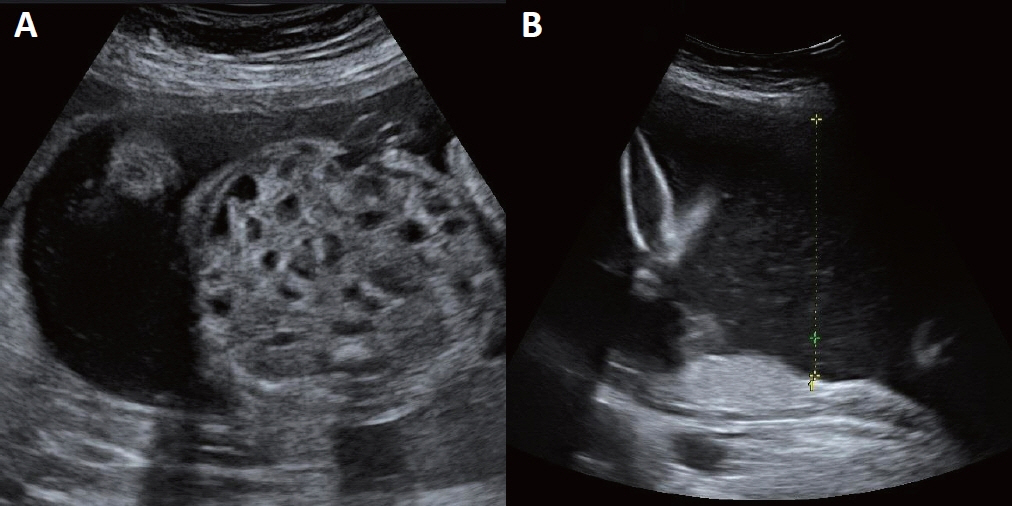Neonatal Med.
2023 Aug;30(3):75-78. 10.5385/nm.2023.30.3.75.
Novel Mutation of SLC26A3 Gene Observed in Congenital Chloride Diarrhea
- Affiliations
-
- 1Department of Pediatrics, Chung-Ang University Hospital, Chung-Ang University College of Medicine, Seoul, Korea
- 2Department of Pediatrics, Chung-Ang University Gwangmyeong Hospital, Chung-Ang University College of Medicine, Gwangmyeong, Korea
- KMID: 2545428
- DOI: http://doi.org/10.5385/nm.2023.30.3.75
Abstract
- Congenital chloride diarrhea (CLD) is a rare autosomal recessive disease caused by mutations in the solute carrier family 26 member 3 (SLC26A3) gene on chromosome 7q31. Affected neonates are vulnerable to dehydration, electrolyte imbalance in the form of hyponatremia, metabolic alkalosis, failure to thrive, or even death if left untreated. Genetic testing for mutations should be considered if the clinical diagnosis remains uncertain because early diagnosis and appropriate management are critical to the disease course in CLD. Several mutations have been reported in Korean patients with CLD, with the most common being the c.2063-1G>T mutation. Here, we report the case of a neonate with prenatally suspected CLD with confirmed novel mutations in the SLC26A3 gene (c.2147C>G; p.Ala716Gly).
Keyword
Figure
Reference
-
1. Norio R, Perheentupa J, Launiala K, Hallman N. Congenital chloride diarrhea, an autosomal recessive disease: genetic study of 14 Finnish and 12 other families. Clin Genet. 1971; 2:182–92.2. Wedenoja S, Pekansaari E, Hoglund P, Makela S, Holmberg C, Kere J. Update on SLC26A3 mutations in congenital chloride diarrhea. Hum Mutat. 2011; 32:715–22.3. Holmberg C. Congenital chloride diarrhoea. Clin Gastroenterol. 1986; 15:583–602.4. Höglund P, Haila S, Socha J, Tomaszewski L, Saarialho-Kere U, Karjalainen-Lindsberg ML, et al. Mutations of the downregulated in adenoma (DRA) gene cause congenital chloride diarrhoea. Nat Genet. 1996; 14:316–9.5. Hoglund P, Auranen M, Socha J, Popinska K, Nazer H, Rajaram U, et al. Genetic background of congenital chloride diarrhea in high-incidence populations: Finland, Poland, and Saudi Arabia and Kuwait. Am J Hum Genet. 1998; 63:760–8.6. Campbell J, Wathen N, Macintosh M, Cass P, Chard T, Mainwaring Burton R. Biochemical composition of amniotic fluid and extraembryonic coelomic fluid in the first trimester of pregnancy. Br J Obstet Gynaecol. 1992; 99:563–5.7. Lee ES, Cho AR, Ki CS. Identification of SLC26A3 mutations in a Korean patient with congenital chloride diarrhea. Ann Lab Med. 2012; 32:312–5.8. Makela S, Kere J, Holmberg C, Hoglund P. SLC26A3 mutations in congenital chloride diarrhea. Hum Mutat. 2002; 20:425–38.9. Hihnala S, Hoglund P, Lammi L, Kokkonen J, Ormala T, Holmberg C. Long-term clinical outcome in patients with congenital chloride diarrhea. J Pediatr Gastroenterol Nutr. 2006; 42:369–75.10. Di Meglio L, Castaldo G, Mosca C, Paonessa A, Gelzo M, Esposito MV, et al. Congenital chloride diarrhea clinical features and management: a systematic review. Pediatr Res. 2021; 90:23–9.11. Kirkinen P, Jouppila P. Prenatal ultrasonic findings in congenital chloride diarrhoea. Prenat Diagn. 1984; 4:457–61.12. Langer JC, Winthrop AL, Burrows RF, Issenman RM, Caco CC. False diagnosis of intestinal obstruction in a fetus with congenital chloride diarrhea. J Pediatr Surg. 1991; 26:1282–4.13. Tsukimori K, Nakanami N, Wake N, Masumoto K, Taguchi T. Prenatal sonographic findings and biochemical assessment of amniotic fluid in a fetus with congenital chloride diarrhea. J Ultrasound Med. 2007; 26:1805–7.14. Passariello A, Terrin G, Baldassarre ME, De Curtis M, Paludetto R, Berni Canani R. Diarrhea in neonatal intensive care unit. World J Gastroenterol. 2010; 16:2664–8.15. Gamble JL, Fahey KR, Appleton J, MacLachlan E. Congenital alkalosis with diarrhea. J Pediatr. 1945; 26:509–18.16. Darrow DC. Congenital alkalosis with diarrhea. J Pediatr. 1945; 26:519–32.17. Lee YD, Lee HJ, Moon HR. Congenital chloridorrhea in Korean infants. J Korean Med Sci. 1988; 3:123–9.18. Hong J, Seo JK, Ko JS, Cheong HI, Choi JH, Lee JH, et al. Congenital chloride diarrhea in Korean children: novel mutations and genetic characteristics. Eur J Pediatr. 2013; 172:545–50.
- Full Text Links
- Actions
-
Cited
- CITED
-
- Close
- Share
- Similar articles
-
- Identification of SLC26A3 Mutations in a Korean Patient with Congenital Chloride Diarrhea
- Oral Proton Pump Inhibitor for Treatment of Congenital Chloride Diarrhea
- A Case of Congenital Chloride Diarrhea in Premature Infant
- A Case of Secondary FSGS due to Chronic Chloride Diarrhea
- Development of Crohn’s Disease in a Child With SLC26A3-related Congenital Chloride Diarrhea: Report of the First Case in East Asia and a Novel Missense Variant



